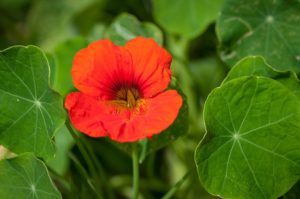
An old shiny silver orb sitting atop a tomato cage graces our small Veggie Demonstration Garden at the nursery. Why on earth is it there? Does it reflect more light around so the plants grow better? is it a bird deflector? A fun house mirror for the squirrels? All good reasons, but no, not really. It’s just an impromptu decoration for the garden – simple, charming and eye catching. Helping to add some height to the initial short plants, it makes a nice focal point for your eyes to rest on. Do we care if the veggie garden has a focal point? Well, it is one way to bring in some thoughtful style to your yard, which can ramp up your enjoyment of it. When you are sitting out in your yard on one of our delicious summer evenings after you have just enjoyed some of your garden’s bounty, take a look around and envision some of these ideas to enhance your edible garden design for the next season:
Focal Points
Add some interest. Make it fun . . . or elegant or modern or Japanese or gnomish or whatever your personal style is. Think colorful glazed pottery, metal artwork for the fence or wall; simple painted bamboo teepees for cucumbers and beans to climb; a burbling fountain alive with glinting splashing water.
Evergreen/Deciduous
Play off deciduous and evergreen plants with each other. Wow does Sweet Bay Laurel make a beautiful hedge or tree (use the leaves fresh for seasoning!), and it pairs so nicely with other edibles which go dormant during winter months, such as blackberries, raspberries, dwarf peaches and nectarines, and even figs. Other good looking edible evergreen trees or small shrubs are Loquat, Chilean Guava (the variegated variety is uber gorgeous), Strawberry Guava and Kumquat.
Why not companion plant a row of deciduous fruit trees (apples, plums, pears, etc.) with some evergreen flowering shrubs that attract our pollinator friends? Ceanothus, rosemary, manzanita, grevillea, and alyssum are all terrific choices to help with fruit set.
Edging
Neaten up and define the borders of beds with a nice little planting of thyme. Or chives or even some of the greens like chard or colorful lettuces.
Layout
Create spaces in your planting areas as places for you to be in, instead of long static rows. If you are planning more than one raised bed for veggies, why not arrange them with space in the middle between them for a small bistro table and chairs (or that focal point). You can use gravel or flagstones for the flooring. Use a triangle plant spacing for a lusher look.
Start small or with an overhaul – Plan one or two weekend projects, or develop a whole new master plan. It’s all about increasing your enjoyment of your own little piece of the neighborhood while harvesting the freshest possible produce ripe from your own yard!
Follow us in Social Media